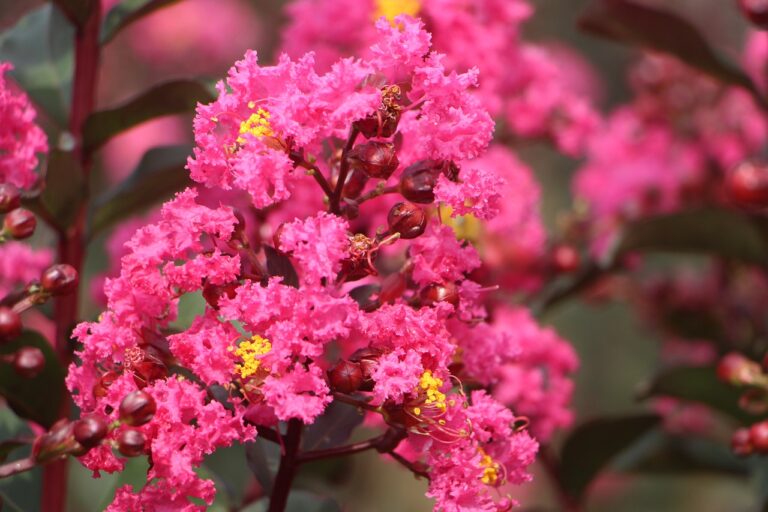Crape Myrtle (Lagerstroemia) is a stunning ornamental plant known for its vibrant flowers, beautiful bark, and excellent drought tolerance. These flowering trees are a staple in many gardens due to their low maintenance needs and versatility. Whether you’re new to gardening or a seasoned pro, this guide will walk you through everything you need to know about growing and caring for crape myrtles.
Introduction to Crape Myrtle Flowers
Crape myrtle trees are a beloved addition to gardens around the world. Their vibrant, colorful flowers bloom in the summer, and they provide year-round interest with attractive bark and foliage. Historically, crape myrtles have been used in landscapes not only for their beauty but also for their ability to withstand hot, dry climates.
These trees come in various sizes, from dwarf varieties perfect for small spaces to large trees that make a dramatic statement in larger gardens. Additionally, they are highly versatile and can thrive in a variety of settings.
For more information on planting crape myrtles, visit the Arbor Day Foundation.
Types of Crape Myrtle Flowers
Crape myrtle trees offer a wide range of flower colors, including:
- Red
- Pink
- White
- Purple
These colors bloom from July through September, giving your garden a splash of color during the hottest months. The most common species are Lagerstroemia Indica and Lagerstroemia Fauriei, with different varieties suitable for different garden sizes. Dwarf, miniature, and standard tree varieties are available, making it easy to find the perfect fit for your landscape.
To learn more about the best growing conditions for crape myrtles, check out this guide to growing crape myrtle trees.
Characteristics of Crape Myrtle Trees
Crape myrtles are known for their:
- Prolific blooms that last for months
- Attractive, peeling bark that adds winter interest
- Glossy green leaves that turn vibrant shades in the fall
- Drought-tolerance once established
These characteristics make crape myrtles one of the most versatile trees for warm climates. Their flowers grow in large, showy panicles, which makes them a favorite for those looking to add height and texture to their garden.
Growing Conditions for Crape Myrtle
To thrive, crape myrtles need:
- Full sun (at least 6 hours a day)
- Well-drained soil
- Moderate watering during their growing season
Once established, these trees are highly drought-tolerant, making them ideal for regions that experience long, dry summers. Be sure to choose a location with ample sunlight for maximum bloom production.
How to Plant and Propagate Crape Myrtles
Planting crape myrtles is a simple process:
- Choose a sunny location.
- Dig a hole twice as wide as the root ball.
- Place the tree or shrub in the hole and backfill with soil.
- Water deeply to help establish the roots.
Propagation can be done through cuttings, seeds, or layering, but cuttings tend to be the easiest and most successful method. Take softwood cuttings in spring, dip them in rooting hormone, and plant them in a mix of soil and sand.
Pruning and Maintenance
Pruning crape myrtles is essential for keeping their shape and encouraging more abundant blooms. However, it’s crucial to avoid the common mistake of “Crape Murder”, where trees are pruned too aggressively.
Here are some pruning tips:
- Prune in late winter or early spring.
- Focus on removing dead or crossed branches.
- Avoid cutting back the main branches too severely.
Proper pruning will help maintain a tree’s natural shape and promote healthy growth.
For more detailed pruning techniques, check out Garden Design’s guide to crape myrtle pruning.
Common Issues and Solutions
Crape myrtles are relatively low-maintenance, but they can suffer from a few common problems:
- Aphids: Can be controlled using insecticidal soap or natural predators like ladybugs.
- Powdery mildew: Prevent by ensuring the tree has good airflow and plenty of sunlight.
- Crape myrtle bark scale: This pest is becoming more common in certain areas and can cause black sooty mold to develop. Treat with horticultural oil and keep the tree healthy with regular care.
For dealing with common pests in your garden, consider learning more in our guide to aphids, which offers tips on prevention and control.
Landscape Uses of Crape Myrtle
Crape myrtles are incredibly versatile in the landscape. They can be used in:
- Ornamental gardens for summer blooms
- As a focal point in front yards
- Along driveways or property lines as a privacy screen
- In mixed borders alongside other perennials and grasses
Thanks to their wide range of sizes and colors, crape myrtles are perfect for any garden style, from formal to natural.
FAQs
When do crape myrtles bloom?
Crape myrtles bloom from July to September and can sometimes continue blooming until the first frost.
How tall do crape myrtle trees grow?
Depending on the variety, crape myrtles can range from 3 feet (dwarf varieties) to 30 feet in height.
Do crape myrtles need full sun?
Yes, crape myrtles require at least 6 hours of full sunlight per day for optimal bloom production.
What colors do crape myrtle flowers come in?
Crape myrtles bloom in shades of red, pink, white, and purple.
How do you prevent crape myrtle bark scale?
Regularly inspect your tree for pests and treat with horticultural oil if needed. Keeping the tree healthy through proper watering and fertilization can also help prevent infestations.
What’s the best fertilizer for crape myrtle blooms?
A balanced fertilizer applied in spring can encourage better blooms. Avoid over-fertilizing, as this can promote excessive leaf growth at the expense of flowers.
Conclusion
Crape myrtles are a beautiful, versatile choice for any garden, with their showy flowers, vibrant colors, and year-round interest. By following the tips in this guide, you can grow and maintain healthy crape myrtle trees that will enhance your landscape for years to come.
Whether you’re planting crape myrtles for the first time or looking to improve your pruning techniques, these hardy plants will reward you with stunning blooms and minimal maintenance.
